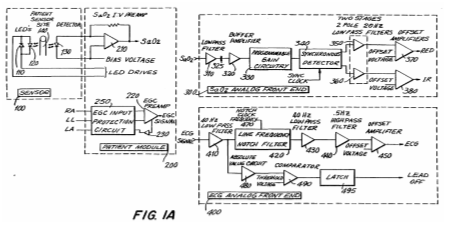
Nellcor Puritan Bennett, Inc. v. Masimo Corp. (Fed. Cir. 2005)
by Baltazar Gomez
Appellant Nellcor owns U.S. Patent No. 4,934,372 (“the ‘372 patent”), which covers a pulse oximeter and method for using signals from red and infrared light, and processing the signals to measure blood oxygen saturation noninvasively. Appellee Masimo also makes pulse oximeters of the same type as Nellcor.
Nellcor filed suit in the U. S. District Court for the Central District of California alleging that Masimo products infringed the ‘372 patent. The district court granted summary judgment of noninfringement. On appeal, CAFC vacated and remanded for further proceeding because the district court erred in interpreting the claims.
Claim 1 of the ‘372 patent covers a method for detecting, digitizing, and processing the signals, separating much of the aperiodic noise from the signal, and calculating the oxygen saturation from the processed signal. Claim 1 describes the processing and separating step as follows:
processing the time-measure collectively to determine a composite waveform having a relative maximum and minimum amplitude corresponding to a composite periodic waveform of the periodic information in the time-measure so that the aperiodic information present in the time-measure is attenuated and filtered from the composite; (emphasis added)
The district court construed the phrase “attenuated and filtered” to mean “reduced and removed,” and concluded that Masimo did not infringe the ‘372 patent.
On appeal, Nellcor argued that the district court erred by construing “filtered” to mean removal rather than simply reduction. In determining the meaning of the phrase “attenuated and filtered,” CAFC examined the meaning the patentee used in the specification of the ‘372 patent. The ‘372 patent describes the relative reduction of the impact of the aperiodic noise by the small relative weight assigned to it that results in it being “quickly and effectively attenuated, and thus filtered out.” The ‘372 patent further describes that the claimed phrase “attenuated and filtered from the composite” is used to refer to “effective removal” of data, rather than the absolute removal of unwanted data. Further, CAFC also looked at the meaning of “filter” in the IEEE standard dictionary which defines “filter” as separation of data, signals, or material in accordance with specified criteria and elimination of certain portions of a signal. The CAFC agreed that the definition from the IEEE dictionary was consistent with the meaning given in the specification of the ‘372 patent. Thus, the CAFC concluded that the district court misinterpreted the claims of the ‘372 patent because the phrase “attenuated and filtered from the composite” means “reduced in comparison to the desired information.”
Vacated and remanded to evaluate whether Masimo infringes based on the new claim construction
Note: Dr. Baltazar Gomez is a scientific advisor at McDonnell Boehnen Hulbert & Berghoff LLP in Chicago. Dr. Gomez obtained his PhD in biochemistry from the University of Texas and researched retrovirology as a PostDoc at Cornell University.
Links:
-
In a parallel case, a jury recently found that Nellcor illegally excluded its competitors from the market for pulse oximeters, a device which monitors oxygen levels in blood. [AP Article]